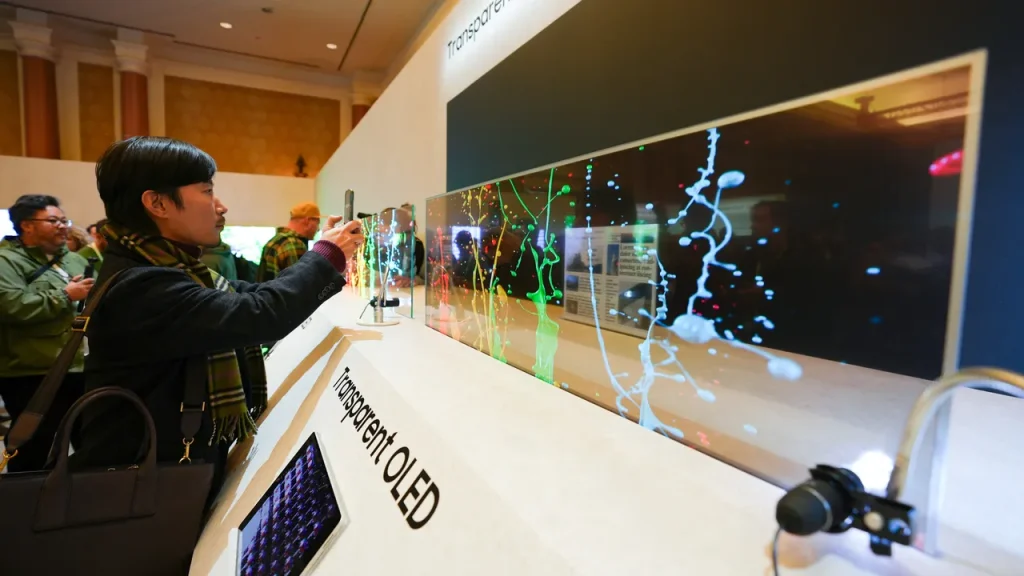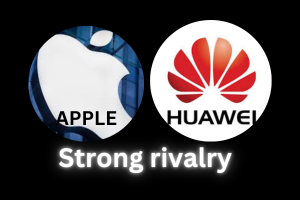Both LG and Samsung unveiled transparent TVs at CES in January. These apparently truly amazing gadgets have the same picture display capabilities as a standard TV, but they also allow for direct seeing through them. The pictures appear to hover in midair. They appear to be merely a piece of furniture when they are switched off..
For the foreseeable future, these will most likely be the preferred choice of the wealthy for use at home.
Transparent displays are likely to be put to good use in the world of outdoor advertising. They would probably be used to enhance the information you see through it, allow for more interesting teleconferencing, add advertising while maintaining clarity, and more.
The likely thought going through a person’s mind right now would probably be, “How can a television be made transparent? You need wires and everything, don’t you? How can the pixels get so small that you can see through the TV? Does this magic have a performance penalty?”
We met with Jacky Qiu from OTI Lumionics, which has been working on these displays for years, most recently with LG, even though neither LG nor Samsung have provided much information.
This is what we discovered.
Transparent TVs and their non-transparent predecessors are very alike in several aspects. These require new technology to function, but in many respects, this is more evolutionary than revolutionary.
Let’s start by going over the fundamentals that are required for every TV to produce an image. The first thing you need is an image-creating entity, and the pixel is the first of these. The term “picture elements,” or pixels, is a portmanteau that varies somewhat based on the technology of the TV. For example, OLED TVs are made of a stack of organic components that, when powered by electricity, create light. It’s a comparable stack made of a different material with MicroLED.
The great majority of TVs on the market are LED LCD models, but we’ll ignore them, because transparent TVs do not employ this technology.
In addition to the pixels, a means of supplying power to them is also required. To produce an image, you must be able to tell each pixel when and how bright to be. To keep things simple, we’ll just talk about the pixel as a whole. However, each pixel is made up of three—or perhaps four—sub-pixels that individually produce the colors red, green, blue, and at times white.
To put it very simply, imagine a huge game of Battleship between all these wires that are used to address each pixel. The TV’s CPU will signal the equivalent of “E6” if you require a certain pixel to turn on, in which case the pixel located at that address will turn on. That’s just a basic idea; it’s far more intricate and occurs thousands of times each second over the millions of pixels of a TV.
The issue with transparent TVs is that neither the cables nor the pixels are actually transparent. It’s really to the contrary. Therefore, before transparent TVs are made possible two things had to happen.
The pixels needed to be made brighter. The light-emitting portion of the pixel might be reduced while keeping the same, or at least comparable, brightness by making them brighter.
Making the wires and other components of the pixel transparent is a more significant task.
You’ve probably handled wires made of copper, aluminum, or a mix of the two materials almost every time. They are definitely solid and opaque.
Transparent materials like indium tin oxide, which is also used for touchscreens, let electricity pass through them.
The area surrounding the pixels is now open for light to travel through since the wires are mostly hidden and the pixels’ light-emitting regions have shrunk. That is the main disguise. Instead of being “clear,” transparent TVs are more like “clear-ish.” The panels’ mesh is very fine. Consider yourself a distance away from a screen door. The cables are visible if you get near, but you can see right through it. Transparent televisions are an example of this. You can see the pixels if you approach very near, such as using a microscope.
The actual pixels are smaller and have wider spacing between them than those on a comparably sized conventional TV.
And then the remaining parts of the TV. On a typical TV, there are circuit boards, inputs, and other components behind the screen. These can be mounted in an external device that is connected by cable or underneath the screen, as in LG’s commercial 55EW5F-A, which is now discontinued. After then, removing the opaque rear panel is all that’s needed to get the seemingly magical outcome.
To watch a TV show normally, the final stage for home usage is to have a device to reverse all of that and make the TV opaque. That’s the main problem. No TV is able to “create” black. Anything meant to be dark is visible on a transparent TV.
The LG prototype at CES had a retractable anti-reflector that rolls up a black screen behind the transparent TV to make it into a regular TV.
Everything about it sounds much simpler than it actually is. For the foreseeable future, transparent TVs will be exceedingly costly because of this. I don’t think most people will want an expensive transparent TV at home either, except from the fact that it’s unquestionably amazing and a great discussion starter.

Performance is the other problem, aside from cost. A transparent TV’s pixels will always perform poorer than those of a non-transparent TV with the same technology, regardless of how bright they glow. Those pixels that are so small? The standard TV will have a superior contrast ratio since it will be brighter due to the full-size version’s increased brightness.
One of the least frequent applications for transparent screens will likely be at home. In addition to the commercial opportunities already described, there are store displays with product names and pricing, windshields that indicate speed and GPS directions, windows that provide weather information or other details about the view outside, and more.
Some cars have had heads-up displays installed in the past few years, but the earlier technology was too dim to be used on the full windshield.
It’s not at all shocking to have seen several phones with this functionality, as the structure of a transparent TV is more similar to a phone display than a TV. In this use scenario, only a piece of the screen—where the camera is located—is translucent. The screen is now edge-to-edge, concealing a selfie camera and maybe more, with no more slits or cuts. Imagine having a laptop screen that allows you to look directly at the other person during a Zoom conference, rather than having them look down at your computer.
It will be fascinating to watch how this plays out in regards to preserving image quality while making this work. it will definitely presents some significant design issues.
In the near future, they will probably remain toys for the wealthy when it comes to usage at home. Maybe in spaces without their 200-inch MicroLED walls.
The transparent future at home will come along more slowly for the rest of us, but it will happen much quicker in the corporate outdoor world.







